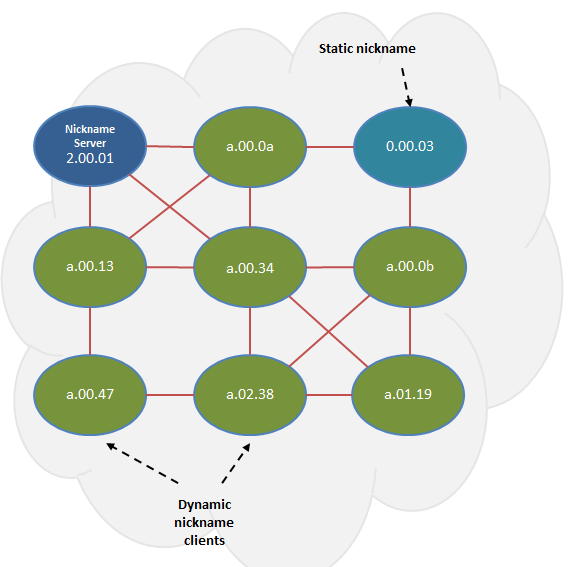Dynamic Nickname Assignment
|
Feature |
Product |
Release introduced |
|---|---|---|
|
Dynamic Nickname Assignment |
5320 Series |
Fabric Engine 8.6 |
|
5420 Series |
VOSS 8.4 |
|
|
5520 Series |
VOSS 8.2.5 |
|
|
5720 Series |
Fabric Engine 8.7 |
|
|
Extends the assignment behavior with a prefix parameter |
5320 Series |
Fabric Engine 8.6 |
|
5420 Series |
VOSS 8.4 |
|
|
5520 Series |
VOSS 8.3 |
|
|
5720 Series |
Fabric Engine 8.7 |
Dynamic Nickname Assignment is a service that provides unique nicknames to compatible switches across a Fabric Area Network (FAN).

You can configure a node in a FAN as a nickname server. The nickname server cannot be started until you configure it with a static nickname. As a best practice, configure at least two nickname servers in a FAN to provide redundancy.

Note
Configure the nickname server with a static nickname that is outside any configured dynamic nickname server range in the network, or you can configure the nickname server with a static nickname from the first 10 values of the configured dynamic nickname server range in the network.
The nickname server interrogates FAN nodes that have been assigned a dynamic nickname to avoid nickname duplication.
A client joining the dynamic FAN in factory default mode initially does not have a nickname, and issues a broadcast soliciting a valid nickname assignment. The nickname server receives the request and responds with a nickname assignment offer. The client then explicitly requests the particular nickname offered and the nickname server sends an acknowledgment.
The client maintains the nickname in persistent memory regardless of whether the active nickname server is the same server that originally provided the nickname. The client generates a trap and notifies the user if it is unable to receive a nickname from the server. When IS-IS starts, it issues a trap if a client does not have a nickname and clears the trap when the client receives a nickname from the nickname server.
A client rebooting or reconnecting to the FAN requests the same nickname assignment it had before reboot. If the requested nickname is within the nickname server‘s configured range of nicknames and is still available, the server acknowledges the nickname. If the requested nickname is outside of the nickname server‘s configured range or if the nickname has been assigned to another client, the request is denied by the nickname server and the client must request a new nickname.
Static and Dynamic Nickname Servers
You can use static nickname assignment and Dynamic Nickname Assignment in the same FAN.
You can configure Dynamic Nickname Assignment using a range prefix that can use a range from 0.00.00 to F.FF.FF. This method provides 256 groups that cover the range of 0.00.00 to F.FF.FF.

Note
You can configure the nickname server with a static nickname from the first 10 values of the configured dynamic nickname server range in the network.
Do not use nicknames from the dynamic nickname range when you assign nicknames statically to non-server nodes. However, if there are existing nodes in the network with static nicknames in the dynamic nickname range, it is not a requirement to change their nickname assignment. If a node is assigned a dynamic nickname that is being used in the network, duplicate nickname protection is initiated. If the node that has the dynamic nickname loses the nickname election, it requests a different nickname from the nickname server. If a node with a static nickname loses the nickname election, IS-IS is disabled on that node and you must manually re-assign the nickname and re-enable IS-IS.

Note
You must disable Dynamic Nickname Assignment before you can change the nickname prefix.
Debugging
A node must be a member of a FAN to host Dynamic Nickname Assignment applications. FAN connectivity enables the exchange of information between nickname clients and servers, such as nickname requests or nickname assignments. You can use Connectivity Fault Management (CFM) to debug connectivity issues or isolate faults. For more information about CFM, see Connectivity Fault Management.
Dynamic Nickname Assignment Considerations
Consider the following information when implementing this feature:
-
You must configure a nickname server to assign unique nicknames to clients based on established policies.
-
You can configure multiple nickname servers in a FAN to provide resiliency. If you configure multiple nickname servers, you must ensure that the ranges for nickname allocation do not overlap.
-
Dynamic Nickname Assignment is not supported in a FAN that contains ERS 4900 or ERS 5900 products, or on products running VOSS releases prior to 7.0.

